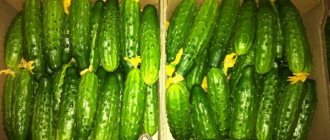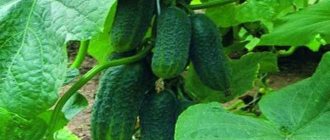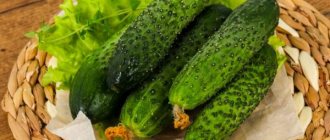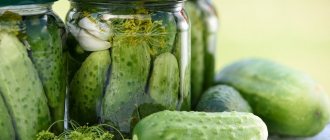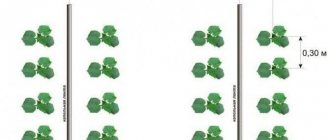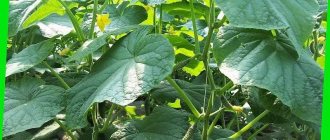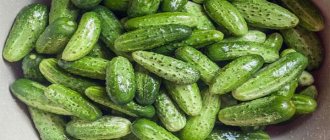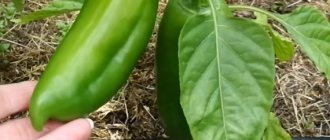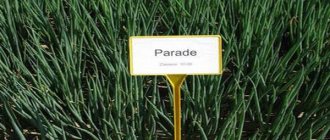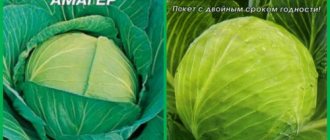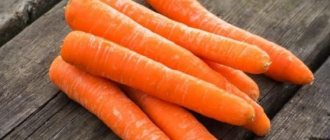Choosing the perfect variety of cucumbers for your garden is an impossible dream for plant growers. After all, in addition to taste, you need to know on what soil it is best to sow it, how quickly the fruits ripen and how suitable they are, for example, for canning. It seems that a cucumber variety close to the ideal one has actually already been bred. All that remains is to purchase seeds from the store and start sowing seedlings. Let's reveal the cards: his name is cucumber Khabar. It seems that this vegetable combines all the advantages that are possible in a cucumber sample. Now let's move on to a detailed description of the plant.
Characteristics of cucumbers Khabar
The cucumber variety Khabar, bred by the Far Eastern Research Institute of Agriculture, was included in the State Register of the Russian Federation in 2000 for cultivation throughout Russia. Refers to tall, early-ripening, mixed-flowering plants. It is characterized by pollination by bees and resistance to temperatures not lower than +5 °C, and therefore the vegetable is perfectly suited for growing in open ground.
According to the description, Khabar cucumbers differ little from other varieties and have the shape of an elongated cylinder and a rich green color with stripes of a lighter shade, as in the photo. Their surface is lumpy, and the growths themselves often resemble thorns. The length of the fruits can reach 9 - 11 cm, while their diameter ranges from 3 to 4 cm. The average weight of one cucumber is 80 - 90 g.
Landing
In order to harvest earlier, the variety is grown in seedlings. You can also sow seeds directly into the soil. Before planting, they are pickled in a one percent solution of potassium permanganate for 30 minutes, then washed with clean water and treated with a stimulant. To speed up germination, you can germinate by wrapping it in a damp cloth and placing it in a warm place.
Seedlings require plastic or peat pots with a nutritious soil mixture. Half of it is prepared from humus, the other half is peat with soil from the garden. Place 2 grains in each container, nose up, moisten and place in a warm place. When the shoots appear, they are transferred to a cooler room with a temperature of +18-20 and good lighting.
The seedlings are grown for 25-30 days, then transplanted.
Optimal conditions for sowing seeds in the ground or planting seedlings are soil temperature +15-20 degrees and no nighttime cold snaps below +8.
The bed must be prepared in the fall. It is picked in a sunny place with little wind. It is advisable that one of the favorable crops grow there before the cucumbers:
- tomato;
- pepper;
- potato;
- eggplant;
- carrot;
- onion;
- cabbage;
- corn;
- any legumes.
Preparation includes deep digging and fertilization with manure, compost or saltpeter. To protect against diseases, the soil can be disinfected with fungicides or potassium permanganate.
Taste qualities of cucumbers
The Khabar cucumber is loved by gardeners largely due to its taste, which sets it apart from other varieties. The vegetable pulp is dense, but despite this, remains tender and juicy. Other distinctive properties of this cucumber variety are its rich, characteristic aroma and the complete absence of a bitter aftertaste. For this reason, Khabar cucumbers are widely used in the culinary industry for making salads and rolls. Vegetables are no less tasty when eaten raw.
Pollination and disease resistance
Pollination of this variety requires the participation of bees, however, Khabar also produces self-pollination. To take advantage of the help of bees, it is necessary to organize constant access of insects to the plantings. In a greenhouse environment, it is not always convenient to leave windows and doors open, as is necessary for pollination by bees.
Khabar cucumbers are resistant to almost all cucumber viruses. Powdery mildew and downy mildew are guaranteed not to affect Khabar. There are only a few diseases that are truly dangerous for this species:
- Ascochyta blight is light gray spots that gradually spread over all leaves, starting from the edges.
- Cucumber bacteriosis can also affect this species. It appears in tropical weather conditions, when heat is followed by rain for several days in a row. Because of it, more than half of the crop may be lost.
- Cladosporiosis is a dangerous disease. It affects the plant so much that the fruits become unfit for consumption. However, using preventative measures, it is possible to protect the plant from death.
Might be interesting
Khabar reacts relatively calmly to
. Preventive treatment will in any case be better than no action at all. The most dangerous things for this species are melon aphids and various types of slugs. For preventive work, it is recommended to use folk remedies, and for the targeted destruction of already appeared insects - chemicals. The best folk remedies to prevent insect reproduction:
- soap solution;
- tincture of lemon or orange zest;
- nettle infusion;
- ash.
The most unfavorable conditions for Khabar are temperature fluctuations. If summer nights are too cold (below 13 ° C) and the days are hot (more than 30), then bacteria begin to develop in the root system. If you flood the plant at this moment, rotting and the development of various diseases will almost certainly begin.
Pros and cons of the Khabar cucumber variety
Based on the description of the properties of the Khabar cucumber, we can conclude about its positive characteristics. The vegetable is distinguished by:
- excellent gastronomic properties;
- no bitter aftertaste when consumed;
- rapid ripening;
- high productivity;
- long fruiting period;
- good transport tolerance;
- possibility of long-term storage;
- disease resistance;
- the ability to grow equally successfully in open ground and in greenhouses.
However, the Khabar cucumber also has certain disadvantages. These include:
- the presence of spines on the surface of the vegetable;
- whimsicality regarding the soil in which cucumbers of this variety grow;
- heat-loving nature of the plant.
And, although the negative properties of the Khabar cucumber to a certain extent affect the subsequent care of this variety, the advantages of this vegetable significantly exceed the existing disadvantages.
Description
The plant is of an indeterminate type, medium-sized, rather climbing, with medium foliage. Mixed flowering type. The leaves are medium-sized, slightly wrinkled, green in color. One ovary is formed in each Khabar leaf node.
The fruits of the variety are elongated-ovoid in shape, small, length 10.4 - 10.7 cm, diameter 3.9 - 4.1 cm. The skin is elastic, of medium density. The color is green, with light stripes of medium length and small round spots. The surface is covered with large tubercles of medium density, the pubescence is black.
The pulp is juicy, quite dense, but tender, the aroma is bright, cucumber. The main distinguishing feature is the complete absence of bitterness. The taste is sweet, the State Register rated the taste of fresh, salted and canned cucumbers as excellent. Vegetable growers fully supported this assessment, ranking the variety among the most delicious.
In recent years, many new cucumber varieties with improved qualities have appeared. One of the most undemanding cucumbers in terms of climatic conditions is the Khabar cucumber - it has a bright taste and is easy to care for.
The Khabar cucumber variety was bred by the famous breeder Olga Migina. Registered in 1999 by the Far Eastern Research Institute of Agriculture.
Since 2000, it has been included in the State Register of Breeding Achievements of Russia and is recommended for cultivation in various regions.
According to their characteristics, Khabar cucumbers are considered one of the strongest and most resistant varieties.
Culture has a number of advantages:
- excellent taste properties, no bitter taste;
- long fruiting period and consistently high yield even under unfavorable weather conditions;
- early ripeness - 40 - 45 days pass from the emergence of seedlings to the first harvest;
- resistance to diseases, in particular to bacteriosis and downy mildew;
- when affected by fungal infections, it is able to quickly restore the leaf apparatus;
- excellent storage and transportability;
- refers to bee-pollinating, but can self-pollinate;
- grows equally well in open ground and in greenhouses;
- versatility of use - cucumbers can be eaten fresh or used for preservation.
There are some negative qualities:
- presence of thorns;
- demands on soil composition;
- thermophilicity.
The Khabar variety is a hybrid of type f1, bred as a result of stepwise crossing of the Japanese variety Tokiwa Zhibai with Dalnevostochny 27 and with the selection sample 0.1723.
Gherkin cucumber, elongated-cylindrical in shape, 9 - 10 cm long, approximately 4 cm in diameter. The peel is thin, with large tubercles, dark green pubescence. When consumed raw, the presence of seeds is not felt. The average weight of the fruit is 90 - 100 g. The yield of marketable products is 90%.
The Khabar variety is easy to grow if you follow certain rules. You need to prepare the area for the cucumber bed in the fall.
The crop does not like acidic soil, so liming is necessary. Depending on the degree of acidity and soil structure, add from 600 g (acidic clayey) to 100 g (slightly acidic sandy) per 1 m. To do this, sprinkle the chemical on the surface of the soil, digging to a depth of 20 cm.
In the spring, the soil is leveled and mineral fertilizers are applied - humus or wood ash. To do this, 1 liter of chicken or 2.5 liters of cow manure is diluted in 15 liters of water.
Excellent harvest when planted correctly
Growing seedlings
Seeds are planted to a depth of no more than 2 cm. Water the soil and cover with film until germination.
Planting in open ground is carried out in the phase of four leaves in the third ten days of May - the first ten days of June.
Transplanting seedlings
To plant seedlings in a previously prepared area, make holes with row spacing of 50 cm, and the distance between plants is 25 - 30 cm.
Cucumber seedlings must be very carefully removed from the boxes, deepened into prepared, moistened holes and compacted with hands.
According to the description, further care of the Khabar variety consists of watering the cucumbers, weeding, fertilizing and preventing pest control.
- Water regularly, once every five days with warm, settled water. 1 liter of water is poured under each bush. After the start of fruiting, you need to water every 3 days with 2.5 - 3 liters of water under the plant.
- Fertilizing with mineral and organic fertilizers alternates. In total, you need to carry out no more than 5 feedings. They must be added to moist soil, right under the root. A couple of weeks after transplanting to a permanent place, fertilize with a solution of mineral substances (2 tablespoons of superphosphate per 10 liters of water mixed with 1 tablespoon of ash) or complex fertilizers: Master, Agricola (description of use in the instructions for the preparation). Repeat after a week. In cloudy weather, foliar spraying is carried out (15 g of urea per 10 liters of water).
- To increase pollinating insects, spray with syrup (2 g of boric acid and 100 g of sugar per 1 liter of water).
- Carry out weeding carefully, because the root system is located in the top layer of soil and is easily damaged. At the same time as loosening, it is advisable to hill up the bushes.
- To stimulate the growth of side shoots, it is necessary to pinch 5-6 leaves. The formation of a bush occurs in stages. First, all ovaries are removed to strengthen the root system. Then, on the shoot in the interval from 4 to 8 leaves, leave one ovary, and pinch the next ovary, repeat the procedure again from 8 to 12 leaves. The bush will take the shape of an inverted Christmas tree.
- In order to prevent infection by insect pests, plants are sprayed with an infusion of garlic, for the preparation of which 100 g of crushed cloves are infused for a week in 1 liter of water and then diluted in 9 liters of liquid. When aphids appear, spray with Actellik or Fitoverma solution (description of use of the drug on the package).
- The final stage of cucumber care is daily harvesting.
Adviсe
If changes in the appearance or size of the fetus are detected, it is necessary to determine what is preventing it from developing correctly:
- the shape of the light bulb with a narrowing at the stalk indicates a lack of potassium (add 1 liter of ash solution under the root);
- hooked cucumbers do not have enough potassium phosphate, spray with the solution (1 tsp per 1 liter of water);
- a thin tip and a thick belly indicate a lack of nitrogen, add organic matter;
- bitter from lack of moisture and temperature changes, watering with warm water will help get rid of them;
- whitish and small lashes - spraying with urea (15 g per 10 liters of water).
READ MORE: Step-by-step cultivation of cucumbers in a barrel, photos and useful tips || Growing cucumbers in a barrel step by step with photos and videos
The hybrid cucumber Khabar, bred by breeders, is suitable for small farms and private gardens. Its description and recorded characteristics of the variety allow the crispy vegetable to be used for canning, salads, and pickling. It’s easy for beginners to figure out how to independently care for gherkin-type fruits.
The first harvest can be harvested a maximum of 45 days after sowing. The early ripening variety is distinguished by a high degree of resistance to pathogenic environments and pests. The only enemy is sudden temperature changes and lack of moisture. The fruits delight with their taste characteristics. During the meal, guests at the table will appreciate the characteristic crunch. The seeds will not be felt.
A tall bush with a medium type of branching provides a yield of 4 kg per 1 m². Under conditions of the predominance of negative environmental factors, the indicator drops to 2.5 - 3 kg per 1 m². Other characteristics:
- rapid restoration of the leaf apparatus;
- adapted for cultivation in urban environments;
- suitable for commercial cultivation;
- suitable for regions with short summers;
- the flesh is dense, but at the same time tender;
- mixed type of flowering;
- withstands frosts up to 5 C;
- suitable for cultivation in the CIS countries;
- thin dark green peel.
The average yield of marketable products does not exceed 90% of the initial volume of the harvested crop. The variety was bred in 2000 by employees of the Far Eastern Research Institute.
By following the rules of care, the summer resident is protected from the bitter cucumber aftertaste. In almost all climatic zones, with the exception of the northern regions, the yield is at a stable level. Other strengths and weaknesses of the Khabar variety.
Long fruiting period
Very demanding on the physical and chemical characteristics of the soil
Resistance to bacteriosis and downy mildew
Demanding on the minimum and maximum ambient temperature values
Quick recovery after a fungal infection
Can be stored for a long time
Tolerates transportation well
Despite the fact that the variety is pollinated by bees, it can pollinate independently, but the yield will be less
Feels equally good in a greenhouse and in open ground. The only caveat is that in a garden bed that is not protected from the vagaries of nature, sudden temperature changes must be excluded.
The hybrid variety "Khabar" is less susceptible to bacterial, fungal, and viral infections. Good immunity is not a reason to refuse to take basic precautions:
- without exception, all seeds that are planned to be used are immersed for 2 hours in a weak solution of potassium permanganate;
- 4 hours before planting, the soil is fertilized, taking into account its acidity level;
- diseased or damaged plants are removed immediately;
- Damaged parts of the cucumber bush are immediately removed.
Having noticed damaged leaves on the seedlings, I cut them off using a sharp and disinfected instrument. After each manipulation, garden tools are thoroughly cleaned.
The gardener's punctuality is the key to a good harvest. Seeds are planted in open ground only with the onset of consistently warm weather. A sharp cold snap will destroy the seedlings. First, the average soil temperature is measured. It should not be lower than 15 C and higher than 22 C. It is important to ensure that the temperature background is stable at night. The soil should not cool below 8 C.
- throughout the growing season, fertilizers are applied no more than five times;
- mineral fertilizing and organic fertilizers are applied separately - a break of at least 3 days is taken between them;
- if the temperature is within normal limits, water the seedlings once every 5 days;
- up to 4 liters of liquid are spent per 1 m²;
- The intensity of watering is increased to 1 time every 3 days from the moment active fruiting begins - the consumption rate is increased to 10 liters per 1 m2.
Optimal growing conditions
Before planting Khabar cucumber on your plot, plants of this variety should be provided with optimal growing conditions. To do this, you need to prepare a seat for the vegetable in advance.
Since the Khabar cucumber is a heat-loving variety, when choosing a place for planting, preference should be given to sunny areas. The best area is where the vegetable will not be exposed to direct sunlight - this way the risk of the cucumber getting sunburn will be minimal. In addition, it is advisable to choose a place that is well protected from drafts.
According to reviews, the soil for growing Khabar cucumbers should also be given sufficient attention. Since the vegetable grows very poorly in acidic soils, before planting you should take care to equalize the pH values of the area. As a rule, this is done in advance, in the autumn, by adding lime to the soil. During the same period, the area is cleared of weeds and unnecessary roots by digging.
In April, the area allocated for planting is dug up again and then leveled. In the second week of May, fertilizers are added to the soil, for example, mineral fertilizer or humus.
Reviews from those who planted
Anastasia, 43 years old
This is the longest cucumber harvest in my entire life. With standard planting in early May, on October 27 I was still picking cucumbers, isn’t this a miracle? There are no complaints at all. The taste is perfect, the crunch is incredibly appetizing. I don’t know if I was just so lucky or if this is really such a variety, but young cucumbers were very convenient to pick. They didn't inject at all.
Vera, 41 years old
I haven’t remembered such a rich cucumber harvest as with Khabar for a long time. At first I planted only for myself. But looking at the amount of harvest that comes out, I realized that we definitely won’t be able to eat everything. I managed to pickle and marinate these cute cucumbers, and then sell them. Good variety.
Khabar is a variety that is resistant to many unfavorable conditions. It is also characterized by high productivity. When choosing, you should definitely take into account some of the features of its cultivation and then the harvest will grow in quality.
Agricultural technology for cucumbers Khabar
Despite the rather extensive preparatory work preceding planting the vegetable, caring for the Khabar cucumber is not too difficult. As a rule, it comes down to watering, fertilizing and periodic treatment against pests and various diseases. There are some nuances in different ways of planting vegetables, but even novice gardeners can do this procedure if they follow a number of recommendations.
Planting seedlings
If we compare this vegetable with other varieties, Khabar cucumber is planted for seedlings quite late, in the first days of May. Sprouts appear after 2 - 3 weeks. As soon as they have at least 4 leaves, the plants are transplanted into the greenhouse.
Advice! It is preferable to plant planting material directly in open ground, as this will facilitate pollination of cucumbers by insects.
Landing in the ground
Another option for planting a vegetable involves directly sowing cucumber seeds in open ground. Just as in the case of seedlings, the procedure takes place from the end of May to the beginning of June. It is advisable to carry out the event after the danger of sudden frosts has completely disappeared and the ground temperature during the day is +15 - 20 °C. Seeds are placed in prepared soil 1.5 - 2 cm deep. In this case, the distance between the beds should be at least 50 cm. As soon as the seedlings sprout, they need to be thinned out so that 4 to 5 plants remain on 1 linear meter.
Important! Before sowing, the seeds must be disinfected using a solution of potassium permanganate to prevent the seedlings from becoming infected with diseases, and then covered with a dark film.
Watering and fertilizing
Timely watering and fertilizing will not only help to achieve a bountiful harvest, but will also have a beneficial effect on the taste of the Khabar cucumber.
The vegetable requires regular and generous watering with non-cold, settled water directly under the root. Moreover, the amount of watering depends on the growth phase of the plant. So, during the period of active growth and flower setting, the Khabar cucumber must be watered once every 5 days at the rate of 3 - 4 liters of water per 1 m2. During flowering and fruiting, watering is carried out more often - once every 3 days using up to 10 liters per 1 m2.
Fertilizing cucumbers of the Khabar variety is carried out no more than 5 times per season, alternating mineral fertilizers with organic ones.
Formation
Since the Khabar cucumber is considered a bee-pollinated variety, when forming a plant, a vertical trellis is usually used, along which one main stem is led. As soon as it reaches the top of the trellis, the stem is pinched and all side shoots and flowers in the axils of the first 3 leaves are removed. Pinching of other shoots is carried out over the 3rd leaf.
Protection from diseases and pests
Although the Khabar cucumber can be considered a variety that is highly resistant to parasites and diseases, insufficient care of the plant can cause various ailments. To avoid this, you should take note of some useful tips:
- Cucumbers of the Khabar variety should be planted only in carefully prepared soil with the required amount of fertilizer.
- It is better to give preference to high-quality seeds from trusted manufacturers that are guaranteed to be disinfected.
- It is necessary to promptly get rid of damaged parts of the plant, dead or diseased specimens.
- Cucumbers should be treated with fungicides and insect repellents from time to time as a preventative measure.
Following these simple rules will help protect this variety of cucumbers from diseases and potential pests.
Landing Features
The cucumber in question is not too demanding on the composition of the soil. However, Cyborg f1 demonstrates the best productivity indicators in light, saturated soils: sandy loam or black soil. The moisture content of the soil is of particular importance for the variety.
Site preparation
They begin to prepare the ground for Cyborg in mid-September. The soil for the variety is dug up to a depth of 60-65 cm, and the larvae of parasites are carefully selected. Then the soil is disinfected with Fitoverm and fertilized with wood ash.
Germination of seeds
Cyborg f1 seeds are added to peat pots in mid-April. Sand, sawdust, compost and coconut substrate are added to the soil. 2 seeds of the variety are planted in each container. They are buried 2-2.5 cm and fed with humus. The cucumber is watered every other day, in the evening after sunset. 10 days before transplantation, the sprouts begin to be hardened in air.
Planting seedlings
The seedlings are ready to be transferred to the ground in mid-May, on the 27-28th day after planting. At this point, the sprouts will have 3 leaves. The hybrid is planted in the ground on a warm, quiet, but not too sunny day. The ideal distance between bushes is 55 cm. The row spacing required by a cucumber is 70 cm. No more than 3 bushes of this variety can fit per 1 m².
